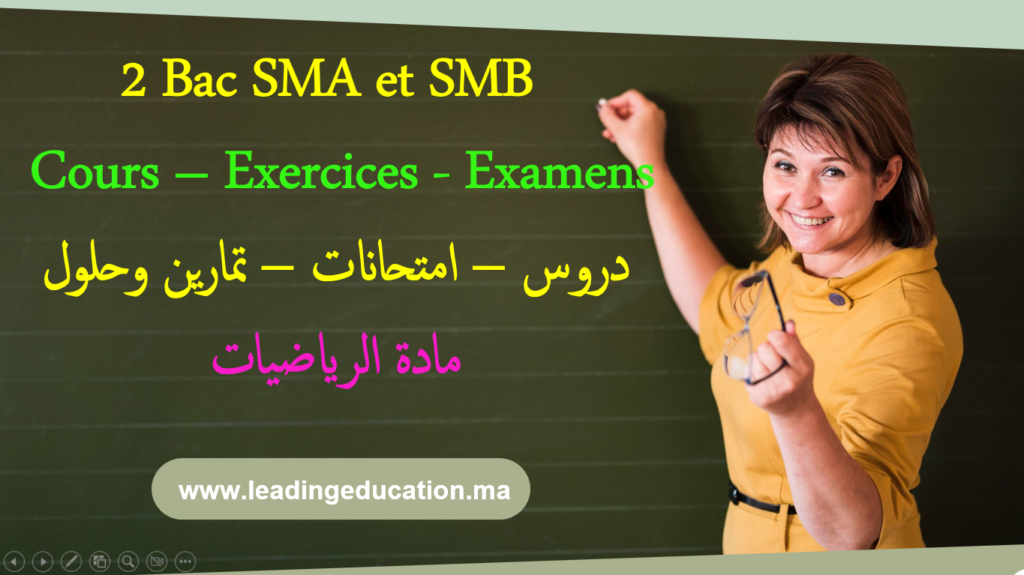10 Exercices sur les Fonctions Logarithmiques
2ème BAC Sciences Mathématiques
Exercice 1 : Calculs algébriques
Simplifier les expressions :
- \( A = \ln(8) – 2\ln(2) \)
- \( B = e^{3\ln(2) – \ln(4)} \)
Solution :
- \( A = \ln(2^3) – \ln(2^2) = \ln\left(\frac{8}{4}\right) = \ln(2) \)
- \( B = \frac{e^{3\ln(2)}}{e^{\ln(4)}} = \frac{8}{4} = 2 \)
Exercice 2 : Résolution d’équation
Résoudre dans \( \mathbb{R} \) :
\( \ln(x+3) – \ln(x-1) = \ln(2) \)
Solution :
Conditions : \( x > 1 \).
Équation équivalente à : \( \frac{x+3}{x-1} = 2 \) ⇒ \( x = 5 \)
Exercice 3 : Étude de fonction
Soit \( f(x) = x – \ln(x) \).
- Déterminer le domaine de définition
- Étudier les variations
- Calculer \( \lim_{x \to 0^+} f(x) \)
Solution :
- \( \mathcal{D}_f = \mathbb{R}^*_+ \)
- \( f'(x) = 1 – \frac{1}{x} \). Minimum en \( x=1 \) (\( f(1)=1 \))
- \( \lim_{x \to 0^+} f(x) = +\infty \)
Exercice 4 : Inéquation logarithmique
Résoudre : \( \ln(2x+1) \leq 1 \)
Solution :
Conditions : \( x > -\frac{1}{2} \).
Solution : \( -\frac{1}{2} < x \leq \frac{e-1}{2} \)
Exercice 5 : Croissances comparées
Calculer les limites :
- \( \lim_{x \to +\infty} \frac{\ln(x)}{x} \)
- \( \lim_{x \to 0^+} x\ln(x) \)
Solution :
- \( \lim_{x \to +\infty} \frac{\ln(x)}{x} = 0 \)
- \( \lim_{x \to 0^+} x\ln(x) = 0 \)
Exercice 6 : Fonction composée
Soit \( f(x) = \ln(x^2 + 1) \).
- Déterminer \( f’ \)
- Étudier la convexité
Solution :
- \( f'(x) = \frac{2x}{x^2 + 1} \)
- \( f”(x) = \frac{2(1 – x^2)}{(x^2 + 1)^2} \). Convexe sur \( [-1, 1] \), concave ailleurs
Exercice 7 : Logarithme décimal
Sachant que \( \log_{10}(2) \approx 0.301 \), calculer :
- \( \log_{10}(5) \)
- \( \log_{10}(200) \)
Solution :
- \( \log_{10}(5) = \log_{10}(10/2) = 1 – 0.301 = 0.699 \)
- \( \log_{10}(200) = \log_{10}(2) + 2 \approx 2.301 \)
Exercice 8 : Équation fonctionnelle
Trouver toutes les fonctions \( f \) continues sur \( \mathbb{R}^*_+ \) vérifiant :
\( f(xy) = f(x) + f(y) \)
Solution :
Les solutions sont les fonctions \( f(x) = k\ln(x) \) avec \( k \in \mathbb{R} \).
Exercice 9 : Application économique
Un capital \( C \) croît selon \( C(t) = C_0 e^{0.05t} \).
Déterminer le temps nécessaire pour doubler le capital.
Solution :
Résoudre \( 2 = e^{0.05t} \) ⇒ \( t = \frac{\ln(2)}{0.05} \approx 13.86 \) ans
Exercice 10 : Problème synthèse
Soit \( f(x) = \frac{\ln(x)}{x} \).
- Étudier les variations
- Tracer le tableau de variation
- Déterminer le nombre de solutions de \( f(x) = k \) selon \( k \)
Solution :
- \( f'(x) = \frac{1 – \ln(x)}{x^2} \). Maximum en \( x = e \) (\( f(e) = 1/e \))
- Tableau : Croissante sur \( ]0, e] \), décroissante sur \( [e, +\infty[ \)
-
- \( k > 1/e \) : 0 solution
- \( k = 1/e \) : 1 solution
- \( 0 < k < 1/e \) : 2 solutions
- \( k \leq 0 \) : 1 solution




Pingback: مادة الرياضيات شعبة العلوم الرياضية ـ أ ـ السنة الثانية بكالوريا 2Bac SMA – موقع التعليم الرائد
Pingback: مادة الرياضيات شعبة العلوم الرياضية ـ أ ـ السنة الثانية بكالوريا 2Bac SMA - موقع المدرسة الرائدة